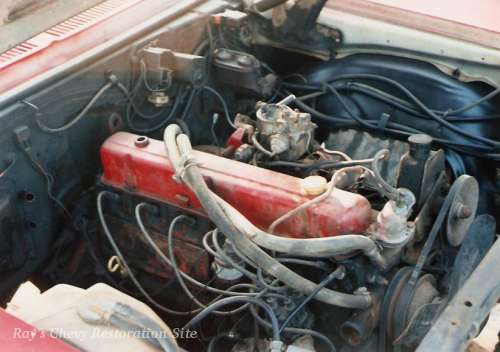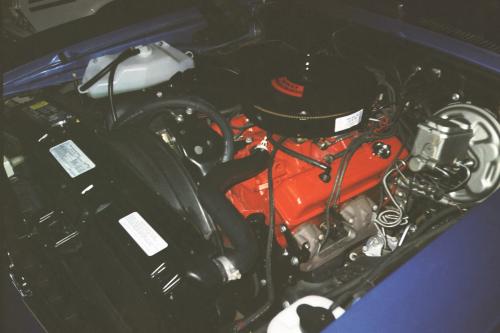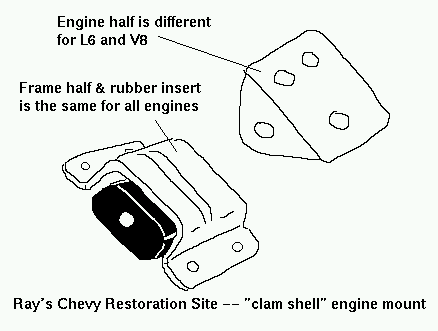This guide outlines the items that I had to change in order to install a 350 cu.in. V8 in place of the 250 cu.in. inline 6 that was in my '74 Nova. Although the details presented here were for my '74, they should apply to '68 to '79 Novas with a few noted exceptions.
The information here applies to installing a small block Chevy V8. A big block swap will involve all of the small block changes plus a few extras. The extras will include big block springs, special heater core and box (although it may fit okay without), and possibly a larger radiator. Since big blocks were a factory option in '68 - '70 Novas, most all of the parts necessary to install one in a '68 - '74 Nova are available through parts suppliers. The '75 - '79 Novas used a subframe that is very similar to the '70 - '81 (second generation) Camaro. Therefore, a big block swap in a '75 - '79 Nova could use exhaust headers and other parts meant for a '70 - '72 big block Camaro.

(the former owner didn't use antifreeze one winter)

(removed from a '74 Nova parts car)
The 350 for this swap came from a low mileage (25,000 mi) but very rusty '74 Nova. Doing the swap from one '74 Nova to another made things much simpler. It provided all of the necessary brackets, wiring, etc. that would otherwise have to be obtained from other sources (junk yards, swap meets, or parts catalogs).
Engine Mounts
Since the extra length of the inline 6 engines (as compared to a V8) is in front of the engine mounts, there is no need to move the mounts forward during the engine swap. In other words, the mount-to-bellhousing distance is the same for both L6 and V8 engines.
1973 to 1979:
These years used an interlocking "clam shell" type engine mounts. The lower (frame halves) of these mounts consist of a rubber core surrounded by a metal shell. They are the same for both L6 and V8 engines and (if the rubber core is good) it is possible to simply leave them bolted to the subframe when doing an engine swap in a 73 - 79 Nova. Some parts catalogs and local auto parts stores sell replacement frame-halves of these mounts. However, the metal shells on the replacement mounts are usually thinner than the originals. Companies such as Energy Suspension sell replacement polyurethane cores for use inside the existing metal shells (installation requires drilling out the spot welds that hold the shells together).

The engine halves of these mounts are "U" shaped steel brackets that are specific to the engine type (L6 or V8). Unlike the frame halves, these brackets are only available new through GM (might be discontinued now) or used (salvage yard, parts vehicle, or such). The original GM numbers for these engine mounting brackets were:
- 3998657 = 73-74 LH
- 3998658 = 73-74 RH
- 334970 = 75-79 LH & RH
I believe the #334970 mounts were also used in many 73+ A-body (Chevelle, ElCamino, GMC Sprint) and B-body (Impala, Caprice) as well as the LH side of 82-89 F-body (Camaro). GM #334971 might also be interchangeable with the #334970 mounts.
Note that many 73 - 90's GM rear wheel drive vehicles used very similar looking engine mounting brackets. However, the large through-bolt holes are located in slightly different positions on some of these mounts. The correct ones for Novas have the large through-bolt hole located about 2-1/4" (on center) away from the side of the bracket that faces the engine block.
pre 1973:
These years used non-interlocking engine mounts (aftermarket interlocking replacements are available). The frame halves of these mounts (perches) are made of steel and the engine halves are made of steel/rubber. Both halves of these mounts are specific to the engine (L6, small block V8, or big block V8). Therefore, both halves need to be replaced during an engine swap. Most parts catalogs sell these type of mounts.

When doing an engine swap in a pre '73 car, the V8 frame halves (perches) will bolt into the same frame holes that were used by the L6 perches.
Note that there were two different engine mounts used on small block V8's during the 68-72 year range. They can be identified by measuring the width between the mounting ears that mate with the frame perch. I believe either style can be used for an engine swap so long as they're used along with the corresponding frame perches.
Cooling System
All V8 Novas had radiators with more cores than 6 cylinder ones. Also note that many cars equipped with factory air conditioning and/or heavy duty cooling systems had wider radiators than cars without AC regardless of the engine.
Most parts car or junk yard radiators will probably be too corroded or clogged to be useful. Nearly all parts catalogs list new radiators but better deals can usually be found at local auto parts stores. The same goes for radiator hoses.
All V8 Novas were equipped with fan shrouds as well. Only later model L6 Novas with A/C or heavy duty cooling received fan shrouds. Reproduction shrouds for '68 - '72 Novas are available from most parts catalogs. I used the fan shroud from my parts car, but a junk yard would also be a good source. Even if a Nova shroud is not available, one from another vehicle could probably be modified to work.
Accessories
Alternator:
Alternators are the same for both L6 and V8 engines, although the two case halves might be clocked differently in relation to one another. Changing that is simply a matter of removing the 4 screws holding the halves together, carefully prying the halves apart a little, rotating them, and screwing it back together. Note, if the halves are pulled too far apart, the brushes will fall out of place and you'll have to take the two halves completely apart, reset the brushes, and put it back together.
1973 was the first year for internally regulated alternators. Swapping from an externally regulated to an internally regulated alternator will require some minor wiring changes. Adapters are available to make the conversion without having to cut or splice any wires.
Starter:
Two types of starters were commonly used on this year range of Novas. One works with a 153 tooth flywheel/flexplate and has the mounting bolts straight across from one another. The other works with a 168 tooth flywheel/flexplate and has the mounting bolts staggered (the one next to the oil pan is farther ahead). The difference between the two is all in the nose piece so it is possible to convert an existing starter but it's usually just as easy to replace the whole assembly. See my Chevy Starter Info page for more details.
Nearly all L6 engines and some early V8's use the smaller 153 tooth flywheel / flexplate and its corresponding starter. While most V8's use the larger 168 tooth flywheel/flexplate and its corresponding starter.
Power Steering Pump:
Power steering pumps themselves are all the same. However, L6 and V8 applications often used different pulleys and reservoir housings. The only difference in the reservoir housings is the angle of the return line pipe nipple. In some cases it can cause interference when used with V8 mounting brackets. The power steering hoses are also different for L6 and V8 applications.
Air Conditioning Compressor:
My Nova does not have AC so I didn't have to deal with this, but most L6's used the short and fairly large diameter R4 radial style compressor. While V8's typically used the longer but smaller diameter A6 axial style compressor. The mounting brackets are completely different and the refrigerant lines that connect to the compressor are usually different as well.
Accessory Brackets
All '68 and earlier small block Chevy engines used short water pumps with a driver side mounted alternator. 1969 and later small blocks use a long water pump, heads with accessory holes, and a passenger side alternator. Either type will work in a Nova engine compartment as long as the corresponding water pump, brackets, and pulleys are used together.Finding an engine with the accessories still in place (such as in a parts car) is the easiest way to go. However, both types of brackets and pulleys are available from most parts catalogs. Junk yards are also a good source as long as everything is taken from the same engine. Subtle year-to-year differences can cause problems when trying to mix and match accessory brackets from different years.
Exhaust
Obviously, the old L6 exhaust system will not work with a V8 engine. Buying a new exhaust system is best since most parts car and junk yard exhaust will be too rusty to re-use. Many parts catalogs sell stock replacement exhaust parts but they're usually less expensive at local auto parts stores. Having an exhaust shop custom build an exhaust system is another alternative. As is purchasing an aftermarket pre-bent exhaust system. I used a #8144710 kit made by Heartthrob Exhaust. It's a mandrel-bent dual 2 1/4" kit made from heavy gauge aluminized steel pipe. I believe it was originally designed for shorter wheelbase Camaros and Firebirds so I had to add a couple extensions to the head pipes in order to properly locate the mufflers. Other than that, it was a really good fit.
Exhaust manifolds or headers will also be required. 1968 - 1979 Novas with small block V8's originally used "log" style manifolds that run down under the spark plugs. These can be found on many other '68 and newer Chevy cars as well as '73 and newer GM trucks.
Early "rams horn" exhaust manifolds might have clearance issues with the positioning of the down pipes in '68-up Novas. And starting sometime in the early 80's some 305 engines used "log" style manifolds that go up over the spark plugs. Those have an interference issue with the oil dipstick if used on an earlier engine with a driver side dipstick. Those manifolds also have one bolt that's in a non-standard location so the hole might not be present on all cylinder heads.
Throttle Linkage
All '70 and later Novas (and maybe some 69's) used a cable to connect the pedal to the carburetor. This cable was the same on my 6 cyl. car and my 8 cyl. parts car. Earlier years used a lever and rod linkage that may need to be replaced with a V8 lever/rod or adapted to work with a V8.
Fuel Line
Most 6-cylinder cars and some V8 cars have a 5/16" sending unit and tank-to-pump fuel line. Others have a 3/8" fuel line. Here's what I've observed:
| Year | 6-cylinder | V8 w/2bbl | V8 w/4bbl |
|---|---|---|---|
| '73 & earlier | 5/16" | 3/8" | |
| 1974 | 5/16" | 3/8" | |
| 1975 - 1979 | 3/8" | ||
I used the 3/8" sending unit from V8 parts car, but since that car was rusty, I installed a new tank-to-pump line. It probably doesn't make a whole lot of difference on a relatively stock engine, but it's nice to have the extra capacity in case of a future upgrade.
Suspension
Depending on the ride height that you prefer, you may want to replace the front coil springs. I found that the original springs were still stiff enough to support the added weight (about 200 lbs) of the 350/TH350 (as compared to the L6/3-speed). The front end sits about an inch or two lower than it did with the 6 cylinder, but I don't have any problems with with it bottoming out or handling strange. I should also point out that this is on a completely rebuilt suspension (new bushings, ball joints, tie rods, etc…).
Electrical Wiring
I think that the only differences in the wiring are due to the different locations of various components (distributor, alternator, etc…). The wiring was another item that I used from my parts car, but it is also available through most parts catalogs. The wiring underwent many changes from year to year, so it is important to check with a wiring diagram if you are doing a swap with a different year/model parts car.
A low budget alternative to replacing the L6 wiring is to modify it to fit the V8 component locations. The modifications will involve shortening and lengthening various wires to reach their new locations. Soldering and carefully insulating all splices is very important if you choose this route. See my Wiring Repair Information page for more details.
Transmission
If you are using a relatively stock V8 engine, then the transmission that was behind the 6 cylinder may be adequate provided that it is in good condition. However, automatic transmissions used in 6 cylinder and V8 applications had different clutch packs. So rebuilding or replacing the transmission is probably a good idea.
The 3 speed manual that was behind the 6 in my car had a lot of miles on it and had taken a lot of abuse from the previous owner. Therefore, I decided to use the low mileage TH350 automatic from my parts car. The manual to automatic conversion was greatly simplified due to the fact that I used the parts car for the following parts:
- Fluid cooler lines that go to the radiator
- Kickdown/detent/TV cable/switch (depending on transmission)
- Dip stick and tube to fit transmission
- Steering column (automatic shifter is different than 3-speed)
- Shifting linkage
- Shift indicator (* see note below)
- Brake pedal
- Plate on firewall that covers clutch linkage hole
The transmission crossmember and driveshaft were the same for both the manual and automatic transmission.
* Note: on 1976 and earlier Novas, the shift indicator is a separate piece that attaches below the speedometer via a couple of screws. Some instrument cluster disassembly is required to gain access to the indicator. Indicators for PowerGlide transmissions will show (PRNDL) and indicators for TurboHydramatic transmissions (TH350 and 400) will show (PRND21). On 1972 and earlier Novas with console mounted shifters, the indicator is located on the console. Starting in 1973, the indicator is located in the instrument panel regardless of shifter location. On floor shift cars, a backdrive linkage is used to rotate the lower steering column jacket. That activates the neutral safety/reverse light switch mounted on the steering column as well as the instrument panel mounted shift indicator. Starting in 1977, the shift indicator is printed directly on the lower part of the speedometer face. So a speedometer swap will be necessary on those cars when switching between manual and automatic transmissions.
Rear Axle
1971 and earlier Novas had either an 8.2" 10-bolt or an 8.875" 12-bolt differential. The 8.2" rears were used with all engines except big blocks and high powered small blocks. A later model ('72 - '79) 8.5" is a bolt-in upgrade that will take the place of an 8.2" in all 1968 to 1971 Novas.
All 1972 through 1975 Novas had 8.5" 10-bolt rear axles. They are nearly as strong as a 12-bolt and therefore should be sufficient with most V8 applications. Note that L6 and V8 cars often used different gear ratios so a speedometer re-calibration may be necessary. Scott Windle has the standard gear ratios for all stock engine/tranny combinations listed on his website, NovaResource.org. His site also has information about speedometer re-calibration.
Starting in 1976, Novas with 6 cylinder engines had weaker 7.5" 10-bolt rears. Original V8 Novas (except the '76 305) were still equipped with the 8.5" 10-bolts. So a 7.5" to 8.5" rear axle upgrade should be considered when doing an L6 to V8 swap in a '76 or newer Nova.
Additional Notes
As you have probably noticed, it really helps to have a parts car when doing this type of swap. Even if the parts car is not another Nova, it will still contain several parts (like engine mounts and accessory brackets) that can be used in the swap. And purchasing a whole parts car is often less expensive than buying all of the parts and pieces separately through catalogs and/or junk yards.
If you are doing a cross-year or cross-vehicle engine swap then a GM parts interchange manual would probably be extremely helpful. Try Hollander for interchange manuals.
- Return to Ray's Chevy Restoration Site Home Page
- e-mail:ray_mcavoy@yahoo.com
- © 1998 - 2026 Raymond McAvoy. All Rights Reserved.